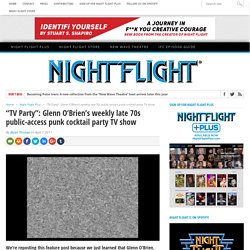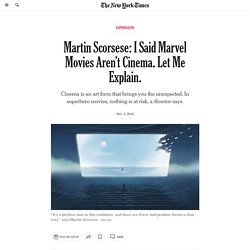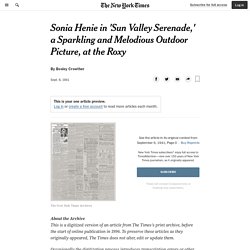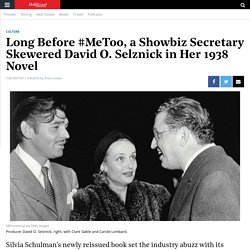

The Story of Glenn O'Brien's 'TV Party' “TV Party”: Glenn O’Brien’s weekly late 70s public-access punk cocktail party TV show – Night Flight. We’re reposting this feature post because we just learned that Glenn O’Brien, who Rolling Stone described as — “a Renaissance man who edited for Rolling Stone and Andy Warhol’s Interview,” and “a fixture of both New York’s punk and art scenes and hosted the public access show “TV Party” — has died at the age of 70.

Read more about O’Brien in his Rolling Stone obit below this original post. Original post: On December 18, 1978, the premiere episode of a new weekly, hour-long low-budget public access variety show called “TV Party” began airing on Manhattan’s Cable’s Channel D, and for the next four years celebrated New York bon vivant and Interview columnist Glenn O’Brien would host live musical performances and interviews with the Lower East Side’s hoi polloi in a cocktail party-style variety talk show setting. When Glenn O'Brien's TV Party Brought Klaus Nomi, Blondie & Basquiat to Public Access TV (1978-82) "This is not a test!

" the host shouts into his microphone. "This is an actual show! " If you lived in New York and had cable in the late 1970s, you may have witnessed it yourself — and you may well have needed the reminder, because this show neither looked nor felt like anything that ever aired before. A fixture on public access Channel D and Channel J from 1972 to 1982, it threw down a redefinition of televisual possibilities that hasn't just survived as a time capsule of the downtown Manhattan scene at its creative rolling boil, but retains its anarchic charge to this day.
Welcome, whether you first tuned in back then or have only just tuned in on the internet now, to Glenn O'Brien's TV Party. O'Brien, who co-created and presided over the show, didn't always shout, but when he did, he managed to retain his deadpan self-possession. Related Content: The Story of Temple Drake: Notorious.
John Bailey Breaks Down a Tour de Force of Gothic Lighting. Among the many enduring virtues of The Story of Temple Drake—a pre-Code William Faulkner adaptation whose sensational depiction of a hopelessly fallen world, rife with sexual violence and other forms of malice, scandalized audiences upon its release in 1933—is its expressive visual style.

Directed by Stephen Roberts and shot by the influential Karl Struss, the film tells its harrowing southern-gothic story through a series of haunting images, from close-ups of searing intensity to dark compositions almost completely enshrouded by shadows. 10 Wonderful Powell & Pressburger Films From the 1940s. If you picture Britain in the 1940s, you'll probably think of spitfires, military uniforms, London being bombed, rationing, dances, and hard times.

You might also think of images that spring from the films of Powell & Pressburger. An RAF pilot standing at the foot of a staircase that stretches upwards; a dancer in red ballet shoes; aircraft flying through the night: in a run of ten films, writer Emeric Pressburger and director Michael Powell left us some of the most iconic scenes ever captured. Here's a look at all of those films. Some are incredibly well known, and others rarely get a mention. The Films Of Powell & Pressburger: A Retrospective. For much of their lifetimes, Michael Powell and Emeric Pressburger never got the due they deserved.

Powell was as English as you could get, had worked his way up through the film industry before coming to the attention of British film magnate Alexander Korda. Pressburger, meanwhile, was Hungarian Jewish by birth, who’d come to Germany in the 1920s to work as a screenwriter, moving to Paris, and then England when the Nazis came to power, and again was working for Korda. When the two met in 1939, there was an instant kinship. They shared a similarly uncompromising and original take on filmmaking, and were soon working hand in hand, sharing credit as writers, directors and producers under the banner of their The Archers production company. Blue Plaque for Film-makers Powell & Pressburger.
Today a blue plaque has been erected to commemorate one of the greatest collaborations in British film history – that of Michael Powell and Emeric Pressburger.

The plaque is on a giant 1930s mansion block near Baker Street, for it was in a small, unfurnished service flat here that the pair set up an office for their production company, The Archers, during the Second World War – they were there from 1942 until 1947. When I visited the block, some time ago now, to see whether it might be a suitable place for a plaque, the flat happened to be empty, and a kind security guard took me up to stand in the empty, anonymous rooms from which so many of their most inventive and best-loved films had been sent out into the world. It was wonderful to think of how much delight had been created here – both for war-time cinema-goers in a darkened London, and for generations to come. Martin Scorsese Wrote a Fire Op-Ed About Marvel: The Best Reactions. Martin Scorsese dropped a bomb on the internet last night when he took to the New York Times to clarify his comments about Marvel movies.

Back in early October, Scorsese gave an interview to Empire magazine in which he said that Marvel flicks aren’t “cinema.” The fanboys freaked, and so Scorsese has responded with an eloquent and clear-eyed op-ed. The venerable director really outdid himself here; the essay explores both how Marvel films are products of studio notes designed for the mass market, and how the film industry at large has become increasingly inhospitable to artists. “Many of the elements that define cinema as I know it are there in Marvel pictures,” wrote Scorsese. “What’s not there is revelation, mystery or genuine emotional danger. “They are sequels in name but they are remakes in spirit, and everything in them is officially sanctioned because it can’t really be any other way,” he continued.
Martin Scorsese: I Said Marvel Movies Aren’t Cinema. Let Me Explain. The climax of “Strangers on a Train” is a feat, but it’s the interplay between the two principal characters and Robert Walker’s profoundly unsettling performance that resonate now.

Some say that Hitchcock’s pictures had a sameness to them, and perhaps that’s true — Hitchcock himself wondered about it. Sonia Henie in 'Sun Valley Serenade,' a Sparkling and Melodious Outdoor Picture, at the Roxy. For those of us who may never get to Sun Valley, Idaho, and may never have the pleasure of racing madly down its white ski slopes or partaking of the many other luxuries of one of the world's most magnificent Winter resorts, Twentieth Century-Fox has well provided a poor man's substitute.

For in "Sun Valley Serenade," which brought the breath of Christmas in September to the Roxy yesterday, an otherwise modest musical picture has been converted into a visual delight through the use of a Sun Valley background, many shots of the spectacular outdoors, breath-taking visions of skiers rocketing perilously down mountain-sides—and also by the presence of Sonja Henie, more charming and lithesome than ever, in the cast.Too often a musical picture is all cluttered up with plot.
But this time the wily producers have found the blessing of simplicity. SUN VALLEY SERENADE, screen play by Robert Ellis and Helen Logan; from a story by Art Arthur and Robert Harari; directed by H. Long Before #MeToo, a Showbiz Secretary Skewered David O. Selznick in Her 1938 Novel. Cornered by a studio chief, the assistant deftly escapes his lunges.

It could be an excerpt from a #MeToo memoir, but the scene was written more than 80 years ago, by a long since forgotten Hollywood insider. That moment between a young woman and her powerful boss appears in the 1938 comic novel I Lost My Girlish Laughter — a secretary's perspective on studio politics and high jinks — whose publication set Hollywood abuzz (a reissue from Vintage Books bows Nov. 5). There was no doubt that the philandering villain Sidney Brand, with his fevered efforts to secure Clark Gable for a "women's picture," was based on David O. Amidst a Gilbert Adrian Revival, a New Book Sampling the Designer’s Unpublished Memoir Debuts.
From the exaggerated, padded-shouldered “power dressing” defining Balenciaga creative director Demna Gvasalia’s recent spring-summer 2020 ready-to-wear show to the theme of the rivalrous glamour characterizing the FX series Pose, the influence of Gilbert Adrian is in the air. Amidst the revival of a look evoking the sharply tailored style and flamboyance associated with the famed costume designer — who wardrobed MGM classics such as Dinner at Eight, Grand Hotel, The Philadelphia Story, The Wizard of Oz and The Women — comes the book Adrian: A Lifetime of Movie Glamour, Art and High Fashion (Rizzoli, $65), due out Nov. 5.
The most extensive book to date on Adrian (who successfully transitioned from film to fashion by 1941, opening a Beverly Hills salon the following year), the tome pays tribute to his fantastical MGM handiwork and offers a complete assessment of the career enjoyed by “Hollywood’s highest paid couturier,” as he was known in his heyday. Adrian was a polymath. No. No. Yes. Robert Evans, Iconic Hollywood Producer and Studio Head, Is Dead at 89. Robert Evans, the sonorous-voiced film producer and studio chief responsible for some of the most popular and enduring masterworks of the late 1960s and ’70s, died Saturday at the age of 89. Evans had one of the most extraordinarily successful runs in Hollywood history. With box office hits and Academy Award–winning films including Love Story, True Grit, The Godfather, and Chinatown, he took Paramount Pictures from last place in the industry to first.
Five films that he either greenlit or produced—Rosemary’s Baby, Harold and Maude, The Godfather, Chinatown, and The Conversation—have been inducted into the Library of Congress’s archive of “culturally, historically, or aesthetically significant films.” But of all the iconic characters he helped shepherd to the screen—among them Rooster Cogburn, Michael Corleone, and J.J. Gittes—arguably the most fascinating and larger-than-life was Evans himself. Evans was born June 29, 1930, in New York. Producer David O. Disney Is Quietly Placing Classic Fox Movies Into Its Vault. It is, among other things, bad news for movie theaters that depend on repertory screenings to shore up increasingly shaky bottom lines. Photo: Twentieth Century Fox Joe Neff knew there was trouble when the horror films started vanishing. Neff is the director of the 24-Hour Science Fiction and Horror Marathons that happen every spring and fall at the Drexel Theater, an independent venue in Columbus, Ohio.
For this year’s Horror Marathon, Neff wanted to screen the original 1976 version of The Omen and the 1986 remake of The Fly, two of hundreds of older 20th Century Fox features that became the property of the Walt Disney Corporation after its $7.3 billion purchase of the studio’s parent company, 21st Century Fox, was made official this past spring. Struggling Small Theaters Cry Foul Over Disney Throwing Classics In Movie ‘Vault’ Topline: As the movie theater business struggles to stay relevant in an age of cheap streaming services, Walt Disney’s purchase of 21st Century Fox earlier this year has brought about a worrying new trend for smaller theaters, who are finding it increasingly difficult to gain access to and screen classic Fox movies. Since Walt Disney’s acquisition of 21st Century Fox, an increasing number of film programmers and theater managers have found it difficult to show screenings of Fox’s back catalogue of older movies, Vulture first reported.Disney has quietly been placing classic 20th Century Fox movies—everything from The Sound of Music and Fight Club to Die Hard and Home Alone—into its “Vault,” making them mostly unavailable to for-profit theaters.The long-standing “Disney Vault” strategy has kept older Disney movies out of theaters for years or decades in a bid to artificially generate excitement for repertory screenings—but now that’s happening to classic 20th Century Fox movies, too.
Wait, Is Disney Putting Fox Movies Into The Vault? I'm Sorry, But Have You Seen Freaking Dragonwyck? The Horror of The Innocents, and the Forgotten Career of Director Jack Clayton. The Uninvited (1944) Murnau, Borzage And Fox. Murnau Borzage Fox. DVD Review: Murnau, Borzage and Fox - Slant Magazine. ‘Once Upon a Time in Hollywood’: Why the Brad Pitt and Bruce Lee Fight Is Confusing Moviegoers.
A Wikipedia spoiler war created a ridiculous fake ending for Once Upon A Time In Hollywood. Back in Time: Making Once Upon a Time... in Hollywood - The American Society of Cinematographers. Robert Richardson, ASC and a number of his collaborators discuss their approach — both technical and philosophical — to writer-director Quentin Tarantino’s period taleof Tinseltown. Unit photography by Andrew Cooper, SMPSP, courtesy of Sony Pictures.
Written and directed by Quentin Tarantino, and shot by his longtime collaborator Robert Richardson, ASC, Once Upon a Time… in Hollywood centers on two fictional characters. Rick Dalton (Leonardo DiCaprio) is a once-successful television actor whose career is faltering; we see him at work on various films, playing a bad guy on a new Western series for television, and debating whether he should go to Italy to do spaghetti Westerns. Jack Webb: The Lost Visionary and the Birth of the Television Police Drama with 'Dragnet' - Diabolique Magazine. Jack Webb is as important to television drama as anyone who has ever lived. Herb Ellis Dead: Actor and Jack Webb Collaborator on 'Dragnet' Was 97. 26 Facts You Might Not Know about Dragnet.
New to the Criterion Collection, Klute finds a sharply feminist drama in the shadows of paranoid noir. 'Klute': Alan J. Pakula and the Lewis Brothers' Thriller-Disguised Exploration of Human Interactions, Relationships and Psyche. Hold Back the Dawn 1941 Movie: Olivia de Havilland Excellent. Once Upon a Time in Hollywood's Faux 1960s Movie Posters. 'Once Upon a Time in Hollywood' Costume Designer on Recreating 1969 Los Angeles. Production Crew on Recreating 1969 Hollywood for ‘Once Upon a Time …’
Nostalgia Fact-Check: How Does Little House on the Prairie Hold Up? 'Little House on the Prairie's' Nellie Oleson looks back on the hit show 45 years after it started. The gritty true story behind 'Little House on the Prairie' How ‘Fosse/Verdon’ Recreated ‘Big Spender’ Sam Rockwell Talks Fosse/Verdon, Bob Fosse, Michelle Williams - Watch. Kevin Brownlow: Lost Silent Films Can Be Rediscovered in Cuba. Classic Hollywood: For generations, Kevin Brownlow has been the voice for silent films. Interview: Kevin Brownlow. NPR Choice page. Comically surreal: how Dali’s film with Marx brothers came to life. Salvador Dalí’s Would-Be Marx Brothers Movie Is Now a Graphic Novel. Mad Love (1935)
Peter Lorre stars in MGM’s Mad Love (1935) — Immortal Ephemera. Not Available. All Through The Night (1942) – The Blonde at the Film. All Through the Night (1941) and Propaganda in American Films during WWII. THE SCREEN; 'All Through the Night' Action Film About Gangsters and Nazi Spies, With Humphrey Bogart, Opens at the Strand. The Ghoul, aka legendary '70s TV horror host Ron Sweed, has died. Late-night TV horror host Ron 'The Ghoul' Sweed dead at age 70. The Ghoul, popular local late-night TV host, dead at 70. Harrison Ford, Melanie Griffith: 'Working Girl' Oral History. Working Girl at 30: the workplace comedy that changed the game. Nypost. Five Fun Facts About The Dolly Sisters. THE SCREEN; 'The Dolly Sisters,' at the Roxy, Offers Betty Grable and June Haver as Chief Attraction.
The Dolly Sisters. Feinberg: My Afternoon With Luise Rainer, Back When She Was Only 99. Luise Rainer: 20 Things You Didn’t Know About the Legendary Actress. Interview with Jamie Reed, Costume Supervisor for The Vast of Night — Quelle Movies. Slamdance Review: THE VAST OF NIGHT. Slamdance Film Festival 2019 – The Vast of Night – SLUG Magazine. The spectacular rise and tragic fall of the real-life ‘Last Tycoon’
Hollywood’s Ultimate Honor Isn’t the Oscar. It’s the Irving. Irving Thalberg - MGM 'Boy Wonder': Author Mark Vieira Discusses 'Hollywood Dreams Made Real' Remembering REMEMBER WENN. AMC Classics: ‘Mad Men,’ ‘Breaking Bad’ … ‘Remember WENN’? The Greatest Show You've Never Seen: Remember WENN. ‘The Marvelous Mrs. Maisel’ Season Two Spoilers: Midge Goes For Broke. Thewrap. Review The Less-Than-Marvelous Mrs. Maisel Season 2. Orry-Kelly Style in 1942's THE MAN WHO CAME TO DINNER. The Seminal Gay Film 'The Man Who Came To Dinner' Originates The Art of Shade.
Recalling 'The Man Who Came to Dinner' with Orson Welles. - The Washington Post. The Petition to Save FilmStruck Has Over 25,000 Signatures. The Story of Orson Welles’s Unfinished Film, The Other Side of the Wind. Lost for decades, Orson Welles’ The Other Side Of The Wind is a brilliant blast of ’70s Hollywood mania. The Cabinet of Dr. Caligari: The World's First Horror Movie. Why is "The Cabinet of Dr. Caligari" considered the definitive German expressionist film. Metropolis, Dr. Caligari, and the Aesthetics of Expressionist Cinema.
Book Review : Great Novel Examines World War II. WOMEN AT WAR. An Extraordinary Kaleidoscopic Novel of World War II - Off the Shelf. You Must Remember This Journeys into the Heart of Hollywood Babylon. 'You Must Remember' This Conversation With Karina Longworth. You Must Remember This: the woman spilling Hollywood's long-held secrets.
‘Dietrich & Von Sternberg in Hollywood’ Review: Mining Cinema’s Golden Age. REVIEW: "DIETRICH & VON STERNBERG IN HOLLYWOOD"; CRITERION BLU-RAY SPECIAL EDITION - Cinema Retro. Gorgeous Criterion Box Set for Dietrich & Von Sternberg in Hollywood Revisits Influential Collaboration. Two Cuts of Howard Hawks’s “The Big Sleep” Reinventing Philip Marlowe. Beyond Bogart: 7 (Other) Faces of Raymond Chandler’s Philip Marlowe. OSS 117: Five Film Collection (OSS 117 Is Unleashed/Panic in Bangkok/Mission for a Killer/Mission to Tokyo/Double Agent) (Blu-ray) : DVD Talk Review of the Blu-ray. OSS 117: Cairo, Nest of Spies Movie Review (2008) Film.avclub.